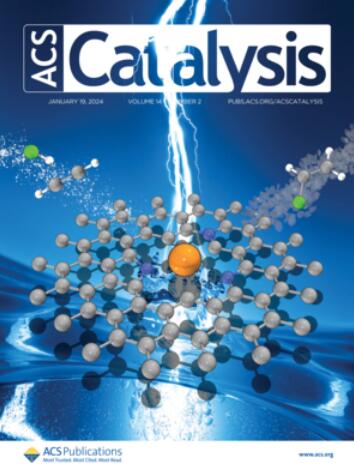构建共价有机框架跨尺寸的高效H2O2光生产
IF 13.1
1区 化学
Q1 CHEMISTRY, PHYSICAL
引用次数: 0
摘要
具有定制功能的不同尺寸共价有机框架(COFs)的合理设计引起了人们的广泛关注。然而,尺度和光催化活性的相关性仍然模糊不清,严重制约了高效光催化剂的构建。在此,我们对COFs的尺寸控制进行了全面的研究,以促进H2O2的整体光生成。我们巧妙地设计了化学成分相似但维度不同的BYTT-COF和BYTD-COF,两者在H2O2光合活性上存在显著差异。在不添加任何牺牲剂的情况下,2D BYTT-COF的H2O2析出速率为9461 μmol g-1 h-1,是1D BYTD-COF的1.6倍,光化学转化效率为1.02%。大量的实验和理论研究表明,虽然BYTT-COF和BYTD-COF具有相似的光氧化还原催化中心,但相对于BYTD-COF, BYTT-COF的尺寸控制可以优化催化位点的空间排列,提高电荷分离效率。因此,与BYTD-COF相比,BYTT-COF在H2O2演化双路径中与*HOOH解吸和*OH形成相关的活化能垒较低。此外,BYTT-COF还可以从空气、水和自然阳光中持续制备固体H2O2。该研究为高性能光催化剂COFs的尺寸工程提供了有价值的见解。本文章由计算机程序翻译,如有差异,请以英文原文为准。
Architecting Covalent Organic Frameworks across Dimensions for Efficient H2O2 Photoproduction
Rational design of dimensionally diverse covalent organic frameworks (COFs) with tailored functions has attracted much attention. However, the dimension and photocatalytic activity correlation remain confused, severely restricting the construction of efficient photocatalysts. Herein, we present a comprehensive investigation into the dimensional control of COFs for boosting overall H2O2 photogeneration. We ingeniously designed BYTT-COF and BYTD-COF with similar chemical compositions but distinct dimensionalities, which exhibit significant differences in H2O2 photosynthetic activity. Without any sacrificial agents, 2D BYTT-COF achieves an impressive H2O2 evolution rate of 9461 μmol g–1 h–1, 1.6 times higher than its 1D counterpart BYTD-COF, with a solar-to-chemical conversion efficiency of 1.02%. Extensive experimental and theoretical investigations indicate that while BYTT-COF and BYTD-COF possess similar photoredox catalytic centers, dimensional control implemented in BYTT-COF leads to an optimized spatial arrangement of catalytic sites and enhanced charge separation efficiency relative to BYTD-COF. Consequently, the activation energy barriers associated with *HOOH desorption and *OH formation within the H2O2 evolution dual paths are lower for BYTT-COF compared to BYTD-COF. Furthermore, solid H2O2 can be sustainably prepared from air, water, and natural sunlight by BYTT-COF. This study provides valuable insights into the dimensional engineering of COFs toward high-performance photocatalysts.
求助全文
通过发布文献求助,成功后即可免费获取论文全文。
去求助
来源期刊

ACS Catalysis
CHEMISTRY, PHYSICAL-
CiteScore
20.80
自引率
6.20%
发文量
1253
审稿时长
1.5 months
期刊介绍:
ACS Catalysis is an esteemed journal that publishes original research in the fields of heterogeneous catalysis, molecular catalysis, and biocatalysis. It offers broad coverage across diverse areas such as life sciences, organometallics and synthesis, photochemistry and electrochemistry, drug discovery and synthesis, materials science, environmental protection, polymer discovery and synthesis, and energy and fuels.
The scope of the journal is to showcase innovative work in various aspects of catalysis. This includes new reactions and novel synthetic approaches utilizing known catalysts, the discovery or modification of new catalysts, elucidation of catalytic mechanisms through cutting-edge investigations, practical enhancements of existing processes, as well as conceptual advances in the field. Contributions to ACS Catalysis can encompass both experimental and theoretical research focused on catalytic molecules, macromolecules, and materials that exhibit catalytic turnover.
 求助内容:
求助内容: 应助结果提醒方式:
应助结果提醒方式:


